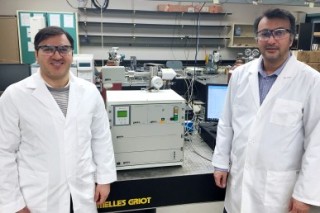Jan 22 2016
Lithium-air batteries can store electricity up to five times that of the more common lithium-ion batteries, but they have their shortcomings. Researchers working at the University of Illinois, Chicago, have developed a prototype that is energized by a surprising chemical reaction, which can solve the lithium-air batteries biggest drawback.
 Amin Salehi-Khojin, assistant professor of mechanical and industrial engineering (right), and postdoctoral research associate Mohammad Asadi with their specially modified differential electrochemical mass spectrometry (DEMS) instrument. PHOTO CREDIT: UIC College of Engineering
Amin Salehi-Khojin, assistant professor of mechanical and industrial engineering (right), and postdoctoral research associate Mohammad Asadi with their specially modified differential electrochemical mass spectrometry (DEMS) instrument. PHOTO CREDIT: UIC College of Engineering
The findings are published in the Jan 11th issue of Nature.
Existing lithium-air batteries (where the metallic lithium of the anode/positive terminal, reacts with oxygen present in air) hold great potential, as they can store energy by way of chemical bonds of oxides. Battery versions tested until recently, store and release energy from lithium peroxide, which is insoluble and chokes the battery’s electrode.
Battery researchers at the U.S. Department of Energy’s Argonne National Laboratory have developed a prototype that produces lithium’s superoxide, and not lithium peroxide, when the battery discharges. Lithium superoxide breaks down into lithium and oxygen, to provide a highly efficient battery with an efficient cycle life.
The Argonne team’s battery consume one electron rather than two, and produce the superoxide, said UIC’s Amin Salehi-Khojin, assistant professor of mechanical and industrial engineering. However, it was not easy to confirm that the reaction took place.
Ex-situ analysis is not accurate enough to prove such a big claim.
Amin Salehi-Khojin, Assistant Professor, University of Illinois
Salehi-Khojin and postdoctoral research associate Mohammad Asadi have devised a modern mass spectroscopy apparatus in order to measure the reaction products in situ when the battery is in charging or discharge state. The system operates under ultra-high vacuum conditions, and is “very sensitive to the tiniest change in oxygen concentration,” said Asadi, a first author on the paper.
As a pioneering effort, the UIC researchers have showed that one electron per oxygen atom is produced, indicating that lithium superoxide, and not lithium peroxide, had formed in the battery. The researchers also showed that no additional lithium compounds were formed as by-products.
This is going to be a valuable system for continuing the study of this battery and other types of metal-air batteries. Not only can we analyze the products of the electrochemical reaction, we can elucidate the reaction pathway. If we know the reaction pathway, we’ll know how to design the next generation of that battery for energy efficiency and cost effectiveness.
Amin Salehi-Khojin, Assistant Professor, University of Illinois
The DOE’s Office of Energy Efficiency and Renewable Energy and Office of Science, and the University of Illinois at Chicago Chancellor’s Proof of Concept Fund provided funds for the research work.
Other authors on the paper are Argonne’s Jun Lu, Dengyun Zhai, Zonghai Chen, Khalil Amine, Xiangyi Luo, Kah Chun Lau, Hsien-Hau Wang, Scott Brombosz, Larry A. Curtiss, Jianguo Wen and Dean J. Miller; Yun Jung Lee, Yo Sub Jeong, Jin-Bum Park and Yang-Kook Sun of Hanyang University in Seoul; Zhigang Zak Fang of the University of Utah; and Bijandra Kumar of the University of Kentucky.